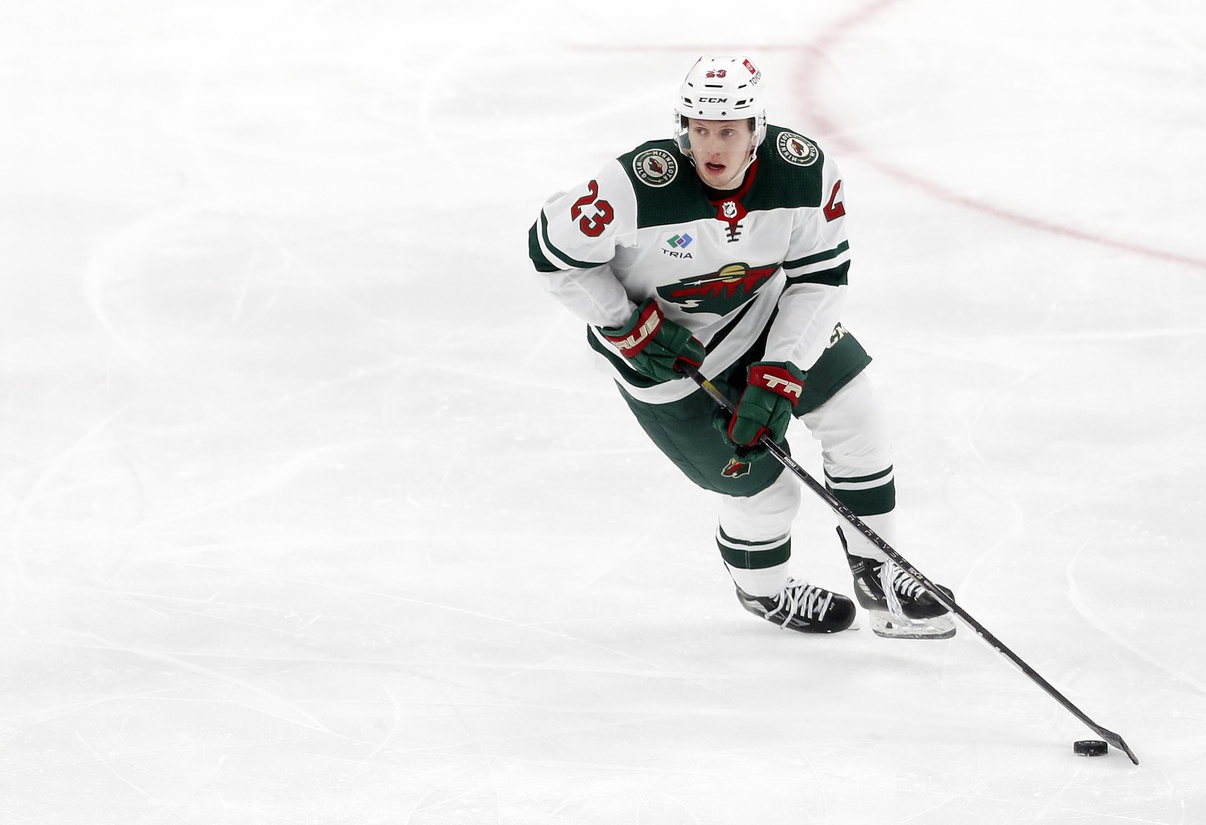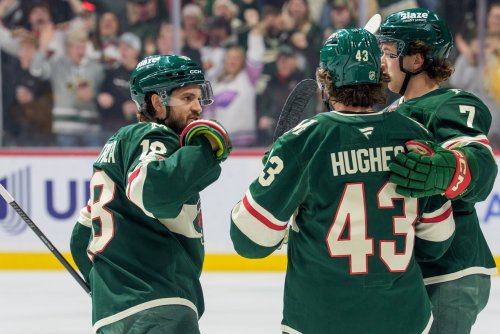
As we close in on the Stanley Cup Finals, fans often create roster-building blueprints for the teams that don’t make the postseason. Fans and media optimistically project each team’s prospects and future cap space until they turn it into a similar version of one of the Cup contenders.
The Minnesota Wild could use the New York Rangers as a blueprint, even if it takes some imagination. They need Jesper Wllstedt to develop into an elite starter, Brock Faber to become an elite top defenseman, and they need to build a deep top-six forward group headlined by Kirill Kaprizov. That would mirror the Rangers’ headliners: goaltender Igor Shesterkin, defenseman Adam Fox, and two high-quality forward lines driven by Artemi Panarin.
Another parallel between Minnesota and New York? They’re hoping for big things out of their 2020 first-round draft picks.
New York kicked off the draft by selecting Alexis Lafreniere, and Minnesota drafted Marco Rossi eight picks later. Rossi and Lafreniere had two exceptional offensive seasons in the CHL before their draft year. However, people have questioned their physicality. They also got off to slow starts in their NHL careers -- Rossi due to complications from COVID and Lafreniere for reasons that weren’t readily apparent.

Rossi has become one of the load-bearing prospects for Minnesota’s Stanley Cup hopes. If he can drive offense from a top-line center role, he could become a foundational member of a championship roster. Lafreniere seemingly did the same for the Rangers this season by filling out their top line.
So how did New York do it, and can Minnesota duplicate it with Rossi?
Lafreniere made massive strides during the 2023-24 regular season and exploded in this year’s playoffs. That led to extensive reporting on what’s changed in his game. There have been four significant changes to his game and his surroundings:
- A dedicated offseason
- Building confidence
- Better linemates
- New systems
In a recent Athletic feature, Peter Baugh detailed Lafreniere's in-season and off-season attitude adjustments after a disappointing 2023 playoff performance. One of Lafreniere’s offseason training partners said, “He was really hard on himself … Couldn’t miss a pass, couldn’t miss a shot. If he was missing a drill, he would repeat it. He didn’t accept failure.”
In the same article, Stephane Dube, who has coached Lafreniere in the offseason since he was 11, echoed the same sentiment about the young winger’s work ethic. “This is where we realized, ‘OK, he turned a corner.’”
In the same article, Stephane Dube, who has coached Lafreniere in the offseason since he was 11, echoed the same sentiment about the young winger’s work ethic. “This is where we realized, ‘OK, he turned a corner,’”
Marco Rossi seems to have already checked that box. Michael Russo reported on Rossi’s single-minded 2023 offseason last summer, and Rossi turned that into a successful ‘23-24 campaign. He seemed to have a newfound confidence that drove him to his first full season of NHL action and 21 goals.
Lafreniere’s teammates also mentioned confidence as a pillar of his improvement in ‘23-24. Three different Rangers -- K’Andre Miller, Braden Schneider, and captain Jacob Trouba -- offered insights into the pressure that the Quebec native placed on himself. Sometimes, pressure makes diamonds, but it can also be a major stressor for professional athletes.
A great way to take that pressure off a young player is to give him a superstar linemate.
Lafreniere got one by the name of Artemi Panarin. Panarin is one of the best offensive players in the league, and center Vincent Trocheck is one of the best offensive players on the Rangers. Based on Dom Luszczyszyn’s analysis in The Athletic, Lafreniere received the 10th-largest offensive boost from his linemates among all NHL forwards.

Compare that to Lafreniere’s 2022-23 linemates, Kaapo Kakko and Filip Chytil. Their 2023-24 player cards below don’t tell the whole story, but they show enough. The contrast is striking, and so are Lafreniere’s improvements.


Panarin and Trocheck also post solid defensive numbers, which can help to shelter young forwards as they develop from NHL regulars to offensive weapons.


Playing on the top line means more difficult assignments, at least on paper. However, when opposing defenders focus on Panarin (the Rangers’ team MVP), it can be a perfect role for high-end prospects to develop their offensive game.
Rossi’s linemates were nothing like Lafreniere’s. While he played a sizable chunk of his five-on-five minutes with Mats Zuccarello (587 minutes, per Per Natural Stat Trick), Matt Boldy (166), and Kaprizov (451), his next most common linemates were Marcus Johansson (331) and Ryan Hartman (235).
Not only did he spend a great deal of time playing with Minnesota’s questionable secondary scorers, but he also suffered from instability. Lafreniere played 1052 minutes with Panarin and 940 minutes with Trocheck. That stability is crucial to developing chemistry and applying systems from the whiteboard onto the ice.
So, can the Wild just stick Rossi next between Kaprizov and Boldy and turn him into a franchise cornerstone? It’s not that simple, of course, but it wasn’t that simple for the Rangers, either. They employed significant tactical changes, which maximized Lafreniere’s skill set. New York hired Peter Laviolette as their new head coach in the summer of 2023, and he brought new systems to Manhattan tailor-made for that top line.
Jack Han, who previously worked as an assistant coach with the AHL’s Toronto Marlies, publishes yearly tactical breakdowns of NHL systems. Han illustrated one of New York’s favorite offensive zone plays from before Laviolette took over. In this play, the Rangers forwards would overload one side of the ice, and defenseman Adam Fox (#23) would drive to the back post as an extra offensive threat.

Then-head coach Gerard Gallant likely drew that up to use Fox’s unique offensive abilities, but this could force one of New York’s forwards (F3 above) to defend the rush if their opponents collected the rebound.
Laviolette still encourages Fox to join in offensive plays but from a more static offensive structure (below). If they turn the puck over, it’s easier for New York’s forwards to turn and defend because they rotate to the point as Fox carries the puck low. Fox can also defend the rush better because his momentum doesn’t carry him into the offensive zone at the time of a turnover.

All this means that Lafreniere can devote more energy to offense and less energy to backchecking.
Han also diagrammed changes to New York’s defensive zone coverage and breakout, which are probably even more significant in Lafreniere’s improvements. In 22-23, the Rangers utilized a common breakout in which defenders move the puck up the boards to force the opponent’s defenseman at the point into conflict.
It keeps the puck safely along the perimeter but is not very dynamic. It also requires multiple consecutive passes that bounce along the boards and past the opponent’s sticks and bodies, which creates many opportunities for an unsuccessful pass.

Under Laviolette's breakout, the Rangers take advantage of their dynamic wingers, threatening to quickly counterattack whenever they retrieve the puck in their own zone. Note how deep and wide Panarin and Lafreniere are in their defensive zone. That allows New York to use its talented offensive players, even if it risks giving up more chances defensively.

Most notably, it uses Lafreniere’s stickhandling and passing ability. Since he’s left-handed and plays the right wing, he can pass to any location on the ice if he turns his back to shield the puck from opposing defensemen. That’s an excellent example of new systems maximizing Lafreniere’s skills and providing him with easy passing opportunities to feed his best teammates.
That’s the recipe for a breakout season. Marco Rossi has already checked the boxes that he has control over. He remade himself in the 2023 offseason and returned a better, more confident player.
Now, the coaches and front office must create an environment that can support that player. This offseason will be the first with John Hynes as head coach, and the team reportedly plans to add a forward. They desperately need that player to improve the team’s secondary scoring, and a great way to achieve that would be to bring in a player who fits Rossi’s skillset.
Rossi could play with the new guy or spend more time with some combination of Kaprizov and Boldy. Whatever the case, Hynes needs to establish strategies that elevate those personnel, or they’ll just be throwing good money after bad. If Minnesota can’t imagine that environment, they will probably trade Rossi to a team that can.
And if they do that, they had better create something special in his place. As Lafreniere has shown in this year’s playoff, it’s easy to make the doubters look foolish very, very quickly.
Think you could write a story like this? Hockey Wilderness wants you to develop your voice, find an audience, and we'll pay you to do it. Just fill out this form.
-
 3
3
-
 1
1







Recommended Comments
Join the conversation
You can post now and register later. If you have an account, sign in now to post with your account.
Note: Your post will require moderator approval before it will be visible.